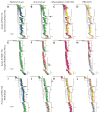The potential for respiratory droplet-transmissible A/H5N1 influenza virus to evolve in a mammalian host
- PMID: 22723414
- PMCID: PMC3426314
- DOI: 10.1126/science.1222526
The potential for respiratory droplet-transmissible A/H5N1 influenza virus to evolve in a mammalian host
Abstract
Avian A/H5N1 influenza viruses pose a pandemic threat. As few as five amino acid substitutions, or four with reassortment, might be sufficient for mammal-to-mammal transmission through respiratory droplets. From surveillance data, we found that two of these substitutions are common in A/H5N1 viruses, and thus, some viruses might require only three additional substitutions to become transmissible via respiratory droplets between mammals. We used a mathematical model of within-host virus evolution to study factors that could increase and decrease the probability of the remaining substitutions evolving after the virus has infected a mammalian host. These factors, combined with the presence of some of these substitutions in circulating strains, make a virus evolving in nature a potentially serious threat. These results highlight critical areas in which more data are needed for assessing, and potentially averting, this threat.
Figures





Comment in
-
Avian influenza. Public at last, H5N1 study offers insight into virus's possible path to pandemic.Science. 2012 Jun 22;336(6088):1494-7. doi: 10.1126/science.336.6088.1494. Science. 2012. PMID: 22723387 No abstract available.
References
Publication types
MeSH terms
Substances
Grants and funding
LinkOut - more resources
Full Text Sources
Other Literature Sources
Medical
Research Materials

